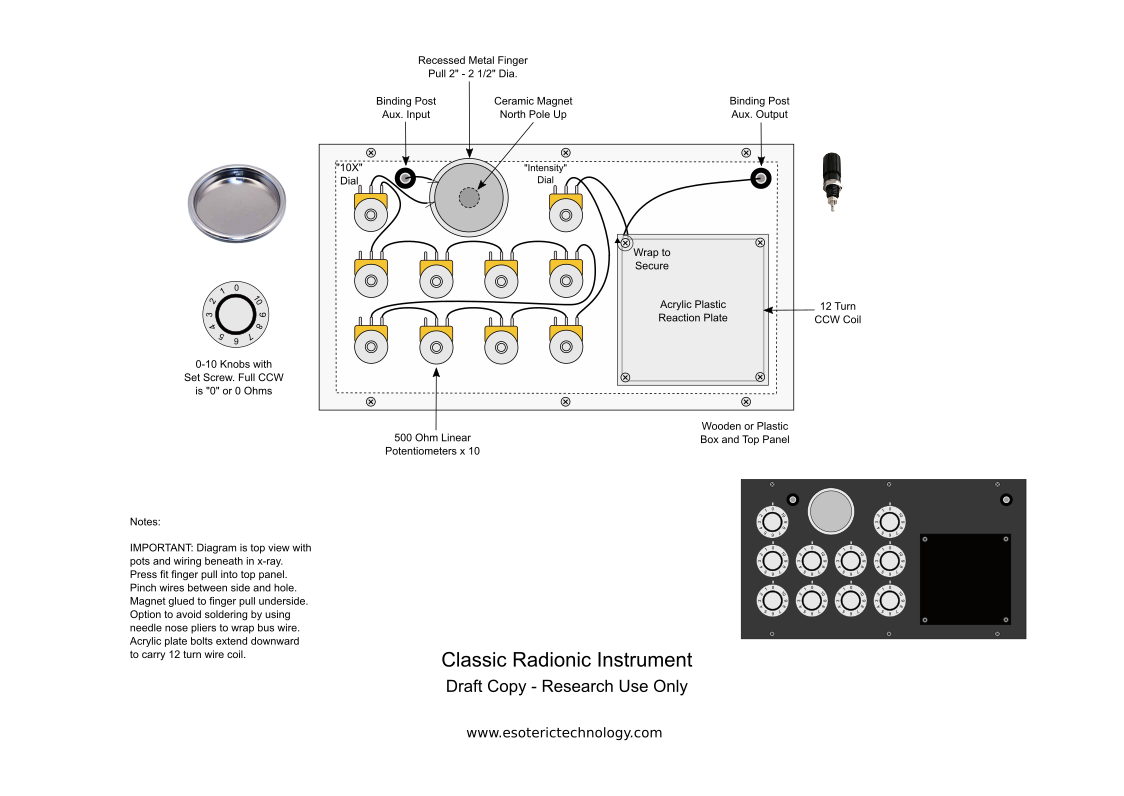Note: This page will soon be replaced with one entitled “Vibrational Transfer”. The information here is still current, but construction of traditional instruments now covered in our new website https://radionicinstument.com/

In the context of this article, “classic” refers to the original black box style instruments pioneered during the early 1900’s by Dr. Ruth Drown and George de la Warr. Although originally nothing more than rotary tuning banks, various spin-offs have been promoted over the years. These include printed tuning cards, electronic amplification and biofeedback or computer inspired operator interfaces. One such recurring theme is improved resolution of the subjective dowsing response pivotal to the analysis stage of operation. However, when closely examined, many are sales strategies to add apparent value or improve customer confidence. Because all rely upon the same subjective reality, tangible outcomes are equally achievable with a simple device.
Being a niche product, radionic instruments can be overpriced relative to the value of included components. This disparity is often obscured by pseudo-scientific advertising jargon and a cultivated mystique. The diagram above is intended to address this situation. It reflects a characteristic hybridization of numeric symbolism and tactile construct that serves to galvanize the will of the operator into a controlled force of manifestation.
Summary of Operation
According to standard procedure, a symbolic representation of the intended subject is placed within the receptacle or “well”. This equates to a quantum entangled, back channel for either remote monitoring or application of telekinetic influence using either of the two methods described below.
The first, being more traditional, identifies the most direct path of action by first performing a detailed analysis of the situation at hand. It relies upon a system of published “rates” that collectively encompass a wide range of both physical objects and their potential conditions. The latter are often denoted by the first numeral being a multiple of ten. One by one, rates deemed most relevant to the purpose at hand are dialed in on the tuning bank. Presence within the subject is indicated by an affirmative dowsing response. This is obtained either with a pendulum or by sensing a tactile sudden adhesion on the built-in “stick pad” while stroking it in a slow circular motion with the fingertips. A quantitative readout of between 0-10 for each item can be similarly determined by slowly rotating the knob nominated as “intensity”.

Once the most significant rates are thus determined, each is broadcast for about 30 minutes several times per day. To accommodate multiple rates at one time, banks of instruments are used, as ilustrated in the photograph below. During this phase of operation, a strengthening result is achieved through dialing the rate in “as-is”. By contrast, to dissipate an unwanted condition each digit is first subtracted from 10 to produce an inverted sequence. For example, 20.7386 becomes 80.3724. All untuned knobs remain on “0”. Entire rate lists for this methodology can be downloaded free of charge from the Literature page, with the proviso they not be applied to actual therapy.

The second method does not require existing rates. They are determined on-the-fly, but as a result do not constitute specific insight as to the underlying condition. Holding one’s preferred outcome in mind, each knob is rotated in sequence until a “yes” response is experienced. If none occurs, leave that knob at “0”. The instrument is now automatically in broadcast mode to predispose the desired tangible result.
In all cases, the intensity knob can be enlisted to monitor the momentum for change, even before overt signs appear. Further information can be found on the Magneto Radionics page, including a 0-100 tuning system and how to utilize the “stick” plate as a mode of dowsed response.
Construction

For simplicity, the diagram at the beginning of this article shows the control panel from top down. In other words, the potentiometers (“pots”) and series connected wiring beneath are in x-ray view. To avoid having to mark the panel, standard 0-10 270 degree, top-hat knobs can be fitted. Alternatively, enlarge and print out the prepared artwork from the Dowsing Tools page. Because manufactured low profile enclosures are rare, one is best custom made from wood with top and bottom of plastic sheet or composite board. The input and output posts are optional, serving only to externalize the respective functions of the receptacle and plate.

In considering “improvements” advocated by other builders, be aware that some may represent self-imposed strictures, or artifacts of subjective bonding with their machine. However, one basic improvement worth implementing is to route the entirety of wiring through an on/off switch and battery powered LED. For this modification, it is preferred to link the pots in parallel to prevent excessive voltage drop that would cause the LED not to glow. The renown psychic Edgar Cayce once stated electricity is the closest thing on Earth to God. According to our observations, the enacted current flow invigorates the circuit by initiating a counter flow within the adjoining ether. Added to this, according to a quantum phase geometry or “Berry’s Phase”, electrons retain a memory of their prior motion in the form of altered spin-orbits. This second order tangental force imparted by circular tuning, then repercusses non-locally as a causal influence upon the predesignated recipient.
Keywords: Radionic instrument, Radionic broadcaster, Ruth Drown, George del la Warr, Malcolm Rae, Walter Russell, Homeopathic potentizer. Non-locality, Berry’s Phase, Vibrational healing, Tiller imprint, Report on Radionics (book)
